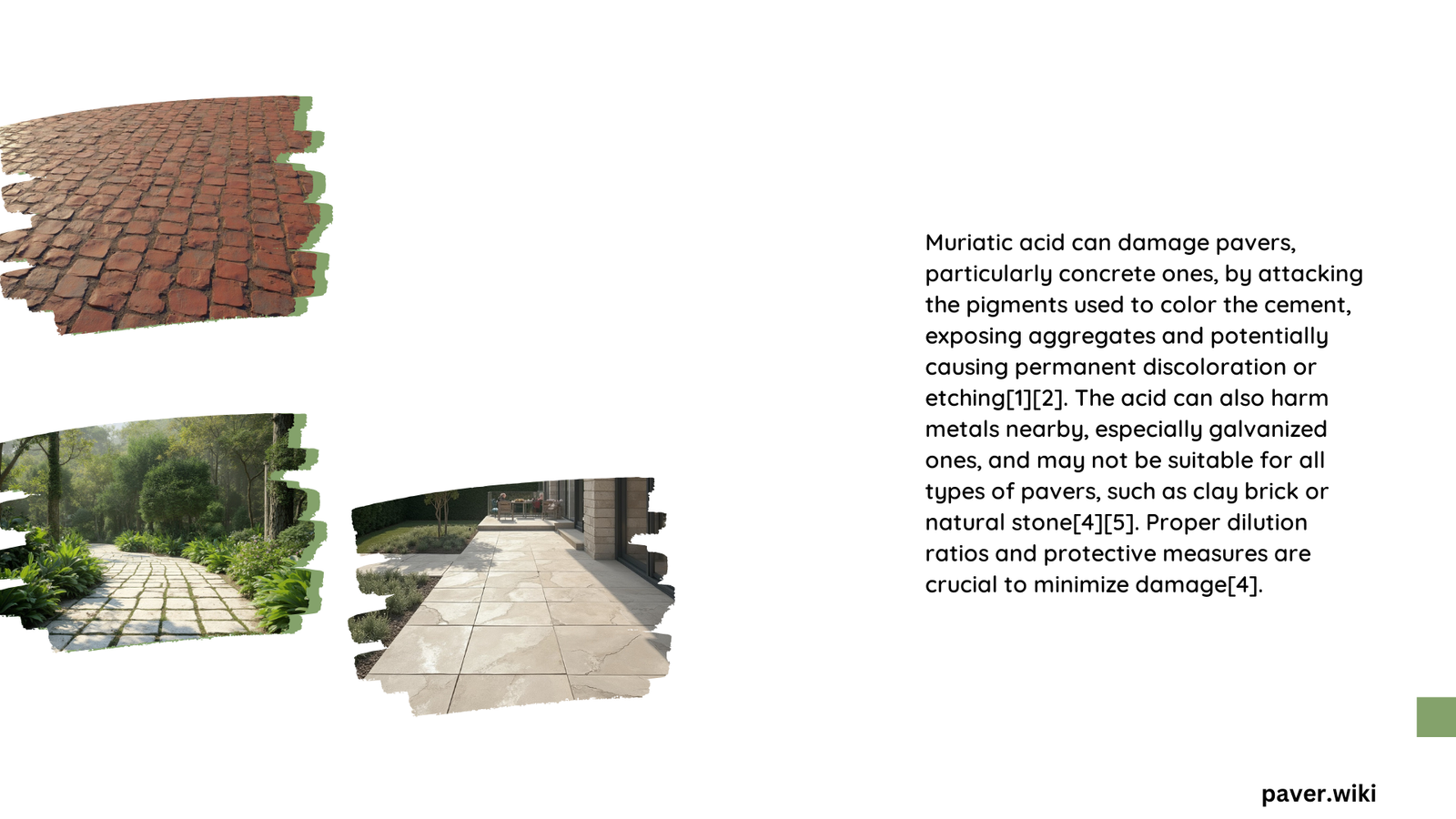Muriatic acid can potentially damage pavers if not used correctly. This powerful cleaning agent, while effective for removing stubborn stains and efflorescence, carries risks of etching, discoloration, and surface degradation. The extent of damage depends on factors such as paver material, acid concentration, exposure time, and application method. Proper dilution and careful application are crucial to minimize potential harm to your pavers.
What Are the Chemical Reactions Between Muriatic Acid and Pavers?
Muriatic acid, also known as hydrochloric acid, can cause various chemical reactions when applied to pavers:
- Concrete Pavers:
- Reacts with calcium hydroxide in cement
- Breaks down cement binder
- Exposes aggregate within concrete
-
May attack color pigments
-
Porcelain Pavers:
- Generally safer when properly diluted
-
Can cause etching if used incorrectly
-
Natural Stone:
- Reacts with minerals in the stone
- Can cause etching and discoloration
- Particularly harmful to calcareous stones like limestone and marble
How Does Acid Concentration Affect Paver Damage?

The concentration of muriatic acid plays a crucial role in determining the extent of damage to pavers:
- Safe Dilution: 21:1 water to acid ratio or higher
- Risky Concentration: Below 21:1 water to acid ratio
- Severe Damage: 1:10 ratio can cause significant etching and surface loss
| Concentration | Risk Level | Potential Damage |
|---|---|---|
| 21:1 or higher | Low | Minimal to no damage |
| 10:1 to 20:1 | Moderate | Possible etching |
| Below 10:1 | High | Severe etching and surface loss |
What Role Does Exposure Time Play in Paver Damage?
The duration of acid exposure significantly impacts the potential for paver damage:
- Safe Exposure: 3-5 minutes maximum
- Risky Exposure: Over 5 minutes
- Severe Damage: 10 minutes or more
Longer exposure times increase the risk of:
1. Deeper etching
2. More extensive surface degradation
3. Greater discoloration
How Does Temperature Affect Acid-Induced Paver Damage?
Temperature can exacerbate the damaging effects of muriatic acid on pavers:
- High Temperatures (above 80°F or 27°C):
- Increase chemical reaction rates
- Accelerate surface degradation
-
Can boost etching rate by up to 20%
-
Low Temperatures:
- Slow down chemical reactions
- Reduce risk of rapid damage
What Are the Long-Term Effects of Acid Exposure on Pavers?
Repeated or improper use of muriatic acid can lead to long-term consequences for pavers:
- Surface Integrity: Up to 10% surface loss or discoloration
- Durability: Reduced lifespan of pavers
- Appearance: Permanent changes in color or texture
- Maintenance: Increased frequency of required upkeep
How Can Acid-Damaged Pavers Be Restored?
Restoring pavers damaged by muriatic acid involves several steps:
- Neutralization: Apply baking soda solution to neutralize remaining acid
- Thorough Rinsing: Clean the area with water
- Drying: Ensure pavers are completely dry
- Sealing: Apply an acrylic sealer for protection
Restoration Costs:
- Minor Damage: $1 to $3 per square foot for sealing
- Severe Damage: $5 to $15 per square foot for stone replacement
What Are the Alternatives to Muriatic Acid for Paver Cleaning?
To avoid potential damage, consider these safer alternatives for paver cleaning:
- Oxygen Bleach: Effective and environmentally friendly
- Vinegar Solution: Mild acid suitable for light cleaning
- Specialized Paver Cleaners: Designed for specific paver types
- Pressure Washing: Effective for removing dirt and grime
How Can Paver Damage from Muriatic Acid Be Prevented?
To minimize the risk of damaging pavers with muriatic acid:
- Always dilute acid properly (21:1 water to acid ratio or higher)
- Limit exposure time to 3-5 minutes maximum
- Test on an inconspicuous area first
- Wear protective gear (gloves, goggles, respirator)
- Rinse thoroughly with water after application
- Consider safer alternatives for regular cleaning
By following these guidelines, you can effectively clean your pavers while minimizing the risk of acid-induced damage.
References:
1. Finishing.com: Muriatic Acid on Brick Pavers
2. eHow: How to Clean Pavers With Acid
3. NTPavers: How to Clean Porcelain Pavers with Muriatic Acid
